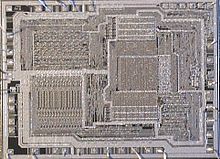Intel 8085
The 8085 had a long life as a controller, no doubt thanks to its built-in serial I/O and five prioritized interrupts, arguably microcontroller-like features that the Z80 CPU did not have.[4] The 8085 incorporates the functions of the 8224 (clock generator) and the 8228 (system controller) on chip, increasing the level of integration.These are intended to be supplied by external hardware in order to invoke a corresponding interrupt-service routine, but are also often employed as fast system calls.One sophisticated instruction is XTHL, which is used for exchanging the register pair HL with the value stored at the address indicated by the stack pointer.[nb 2] However, what would have been a copy from the HL-addressed cell into itself (i.e., MOV M,M) instead encodes the HLT instruction, halting execution until an external reset or unmasked interrupt occurs.Operations that have to be implemented by program code (subroutine libraries) include comparisons of signed integers as well as multiplication and division.A number of undocumented instructions and flags were discovered by two software engineers, Wolfgang Dehnhardt and Villy M. Sorensen in the process of developing an 8085 assembler.These instructions use 16-bit operands and include indirect loading and storing of a word, a subtraction, a shift, a rotate, and offset operations.Intel made a last minute decision to leave 10 out of 12 new 8085 instructions undocumented to speed up and simplify the design of the upcoming 8086 CPU.It is a large and heavy desktop box, about a 20" cube (in the Intel corporate blue color) which includes a CPU, monitor, and a single 8-inch floppy disk drive.A surprising number of spare card cages and processors were being sold, leading to the development of the Multibus as a separate product.It has a small green screen, a keyboard built into the top, a 5¼ inch floppy disk drive, and runs the ISIS-II operating system.In addition to an 8080/8085 assembler, Intel produced a number of compilers including those for PL/M-80 and Pascal, and a set of tools for linking and statically locating programs to enable them to be burned into EPROMs and used in embedded systems.A lower cost "MCS-85 System Design Kit" (SDK-85) board contains an 8085 CPU, an 8355 ROM containing a debugging monitor program, an 8155 RAM and 22 I/O ports, an 8279 hex keypad and 8-digit 7-segment LED, and a TTY (Teletype) 20 mA current loop serial interface.All data, control, and address signals are available on dual pin headers, and a large prototyping area is provided.[citation needed] The radiation hardened version of the 8085 has been in on-board instrument data processors for several NASA and ESA space physics missions in the 1990s and early 2000s, including CRRES, Polar, FAST, Cluster, HESSI, the Sojourner Mars Rover,[12] and THEMIS.Trainer kits composed of a printed circuit board, 8085, and supporting hardware are offered by various companies.These kits usually include complete documentation allowing a student to go from soldering to assembly language programming in a single course.Shared Project versions of educational and hobby 8085-based single-board computers are noted below in the External Links section of this article.


clock rateTechnology node3 μmInstruction setTransistorsIntel 8080Intel 8086microprocessorbinary compatiblemicrocomputerdepletion-modeCP/M operating systemmultiplexedZilog Z80home-computervon Neumanndata busaddress businterruptsnon-maskable interruptwait statesDirect Memory Accesspiezoelectric crystaltwo-phase clockoscillatorinstruction setIndex registersProgram counterStatus registerregistersstack pointeraccumulatorPascalport-mapped and memory-mapped I/Oinput/outputIntel system development kitin-circuit emulatorsemulatorbubble memoryIntel 8048PL/M-80EPROMsembedded systems3 micronTRS-80 Model 100 lineSoviet UniondesignationRussianradiation hardenedSojournerTHEMISprogrammable logic controllersMultibussecond sourcesMitsubishiNEC μPD8085SiemensToshibaSouthbridgeProgrammable Interval TimerOki Electronic Industry Co., LtdSerial CommunicationsParallel I/OCounterIntel 8251Intel 8253Intel 8255Intel 8259ADMA ControllerProgrammable Interrupt ControllerIBM 3740System 34Frequency ModulationModified Frequency ModulationBisyncCCITT X.25Federal Information Processing Data Encryption StandardNational Bureau of Standardsdot matrix printerssingle-board computersIBM System/23 DatamasterIBM PCIntel processorsProcessorsCeleronPentiumItaniumMicroarchitecturesChipsets32-bitP6 variant (Pentium M)P6 variant (Enhanced Pentium M)NetBurstx86-6464-bitPenrynNehalemWestmereSandy BridgeIvy BridgeHaswellBroadwellSkylakeCannon LakeSunny CoveCypress CoveWillow CoveGolden CoveBonnellSaltwellSilvermontGoldmontGoldmont PlusTremontGracemont16-bit80C18780387SX80387DXRapidCADOverDriveA100/A110Original i586Dual-CoreP6-basedNetBurst-based